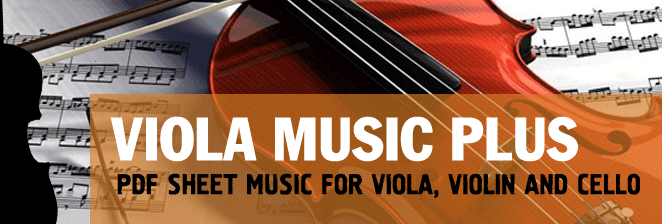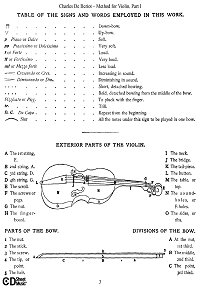|
|
 |
|
| |
| |
Beriot - Method for Violin, Part 1
|
Beriot - Method for Violin, Part 1. You can download the PDF sheet music Beriot - Method for Violin, Part 1 on this page. The course adopted in the first part of this method aims to neglect not one of the essential elements of violin technics. These elements are presented in brief, melodious forms, in order to disguise their dryness as much as possible and render them attractive to the pupil. The chief elements of violin-playing consist of the different tonalities, the various positions, the bowing, double-stopping, etc.
Beriot does not wish to give any one of the primary difficulties undue importance. On the contrary, he has endeavored to give them all equal prominence, utilizing only that which is indispensable to practical teaching. Thus, he has not gone beyond keys of four sharps or four flats, so that the pupil may always have at his disposal the open strings, comparison with which will be necessary to insure purity of intonation. Also, he has considered it advisable to stop at the 5th position, believing that to be quite sufficient for this first, elementary part.
That the progress of bowing may be neither slow nor neglected through a uniformity of exercises. Beriot has considered it advisable to vary the character of the scales, without, however, increasing the difficulty of fingering. This need not prevent the pupil from playing all the scales in whole notes whenever the teacher considers this desirable.
To download PDF, click the "Download PDF" button below the appropriate sheet music image.
To view the first page of Beriot - Method for Violin, Part 1 click the music sheet image.
|
| PDF format sheet music |
|
|
|
Instrument part: 76 pages. 7366 K
|
|
 |
|
|
|
| Download PDF (14.99
€) |
|
|
AUTHOR'S PREFACE.
The results obtained during more than thirty years, in the education of the pupils whom I have had the pleasure of training, constrain me, in some degree, to publish the fundamental principles of my method of instruction.
This work is the fruit of experience as well as of thought. And inasmuch as these principles have been the means of developing so many talented pupils, the labor involved in satisfying my love of perfection has been amply rewarded.
1 take pride in paying tribute to the study of the violin, by presenting a system which is based upon new ideas. Without pretending to have attained all that is possible in the art of teaching, 1 am convinced that I have materially advanced this art by simplifying the educational process.
The present work is divided into three parts, the first and second of which are devoted to the technics of the instrument j the third, to style. Of late years, violinists have been possessed with the feverish ambition to exhibit extraordinary technical skill, often diverting the instrument from its true mission—the noble mission (of imitating the human voice) which has earned for it the glory of being termed "the king of instruments."
The prestige resulting from the display of prodigious technical attainments is, almost always, acquired at the expense of a beautiful quality of tone, perfect intonation, rhythmical accuracy, and, particularly, purity of style.
The excessive work required to overcome these difficulties is calculated to discourage greatly all amateurs. And the eccentricities which, for an instant, dazzle and fascinate, have not, by far, the charm and attraction of melody. Therefore, it is my intention not only to develop the technics of the violin, but also to preserve its true character: which is, to reproduce and expiess all the sentiments of the soul.
For this reason, I have taken the music of song as a starting-point, both as a model and a guide. Music is the soul of language, whose sentiment it reveals by means of expansion; just as language assists in comprehending the import of music. Music being essentially a language of sentiment, its melodies are always imbued with a certain poetic sense—an utterance, either real or imaginary, which the violinist must constantly bear in mind, so that his bow may reproduce its accents, its prosody, its punctuation. Briefly, he must cause his instrument to speak.
Yet one word. I will not outline the didactic virtues which my work may be found to contain. It has been my endeavor to assign everything to its proper place, so that every study shall be presented at the proper moment. Earnest thought should guide the pupil in the study of my method, so that, ultimately, he may become, if not a great violinist, at least an artist of taste and considerable ability. |
|
|
|
|
| |
|
|
| |
|
|
|
|